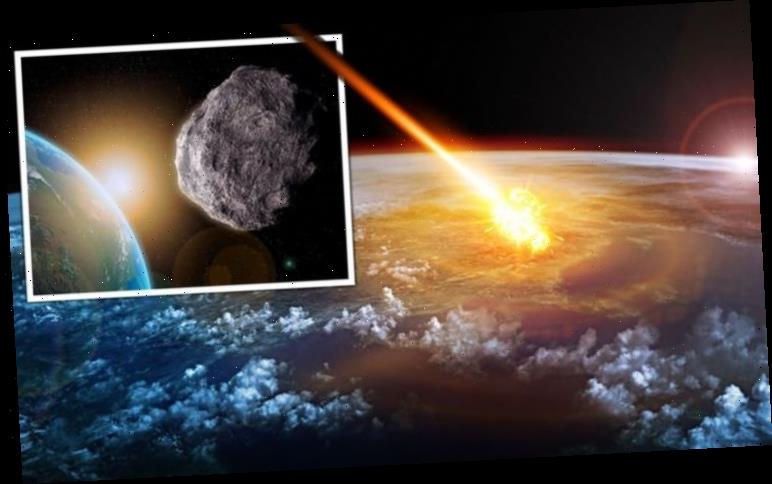An asteroid smashing into Earth’s surface presents one of the most serious threats to the planet. There is evidence the planet has repeatedly been struck by asteroids in the past – with the largest observed crater formed in South Africa, estimated to have hit around two billion years ago.
But, writing in ‘What Does Rain Smell Like?’, meteorologists Simon King and Clare Nasir explain the horrific impacts of an asteroid smashing into the planet now.
They explain how asteroids greater than 25m, but less than 1km would cause “damage on a local scale”, but anything larger than 1km or 2km would have consequences “on a global level”.
They write: “The most lethal repercussions from a large asteroid impact would be wind blasts and shock waves.
“A spike in air pressure could rupture internal organs and wind blast would hurl bodies and flatten buildings and forests.”
They add other damaging impacts include “intense heat, flying debris, tsunamis, seismic shaking and annihilation from the direct impact and cratering”.
They say: “Like other large objects in space, asteroids are influenced by gravitational forces, so they have their own orbit.
“This makes their path relatively predictable. Cataloguing Near Earth Objects (NEOs) is a titanic task, space is very crowded, and it seems to be getting even more crowded with every decade.
“Mapping NEOs against a background of other debris orbiting in space could be described as finding a needle in a haystack, but astrophysicists have made great strides to do just that.”
According to NASA, the current known asteroid count is 888,858.
The space agency says most of the rocky remnants “can be found orbiting the Sun between Mars and Jupiter within the main asteroid belt”.
It adds: “Asteroids range in size from Vesta — the largest at about 329 miles (530 kilometres) in diameter — to bodies that are less than 33 feet (10 meters) across.
“The total mass of all the asteroids combined is less than that of Earth’s Moon.”
DON’T MISS:
Dinosaur discovery: Antarctic clues shows what happened to dinosaurs [INSIGHT]
NASA asteroid tracker: A rock is hurtling towards Earth at 54,000MPH [WARNING]
Comet warning: Stars flinging icy comets THROUGH the solar system [REVEALED]
It also wrote that “as of June 19, 2013, 10,003 near-Earth asteroids are known and the number over 1 kilometre in diameter is thought to be 861, with 1,409 classified as potentially hazardous asteroids – those that could pose a threat to Earth”.
The space agency also has a defence mission to “test of technologies for preventing an impact of Earth by a hazardous asteroid”.
It writes: “DART’s primary objective is to demonstrate a kinetic impact on a small asteroid.
“The binary near-Earth asteroid (65803) Didymos is the target for DART.”
A spike in air pressure could rupture internal organs and wind blast would hurl bodies and flatten buildings and forests
‘What Does Rain Smell Like?’
The tester mission will see DART travel to an asteroid system made-up of two small space rocks known as Didymos A and B when they fly close to Earth between 2022 and 2024.
Lindley Johnson, planetary defence officer at Nasa Headquarters in Washington, said: “DART would be NASA’s first mission to demonstrate what’s known as the kinetic impactor technique – striking the asteroid to shift its orbit – to defend against a potential future asteroid impact.
“This approval step advances the project toward an historic test with a non-threatening small asteroid.”
In ‘What Does Rain Smell Like?’, Simon King and Clare Nasir discuss a range of critical questions about the weather.
Ms Nasir and Mr King attempt to battle myths around the weather while also giving a detailed look into climate change on the planet, as well as climate modification.
The book also discusses how countries around the world are trying to influence the weather in the future, whether it be by “cloud seeding” – with experiments taking place to make a particular area dry for a period, by increasing rainfall elsewhere.
Unpicked are weather phenomena, including cloud formation, the theory behind rainbows, and why certain parts of the world experience extreme weather depending on the time of the year.
What Does Rain Smell Like by Simon King and Clare Nasir out now RRP £12.99 (Bonnier Books UK)
Source: Read Full Article





